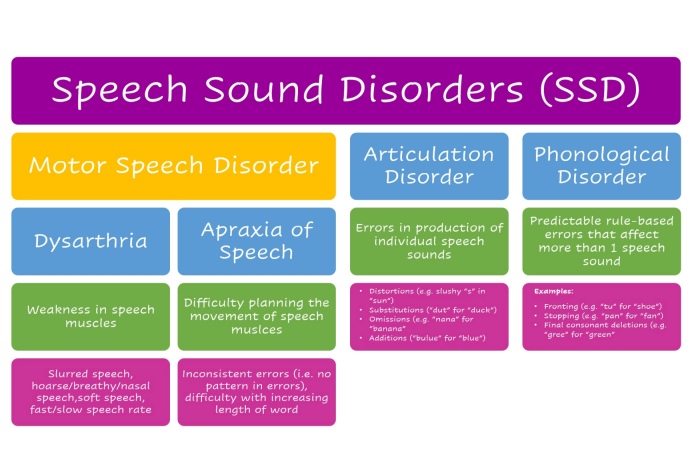
Step into the world of Speech therapy for voice disorders where every word spoken is a step towards clarity and confidence. Explore the journey of transforming vocal challenges into powerful strengths as we delve into the realm of speech therapy techniques and success stories.
Are you ready to discover the secrets behind improving voice quality and communication skills? Let’s dive in!
Overview of Speech Therapy for Voice Disorders
Speech therapy for voice disorders involves the assessment and treatment of conditions that affect the voice, such as vocal nodules, laryngitis, vocal cord paralysis, and more. Speech therapists work with individuals to improve vocal quality, pitch, volume, and overall communication.Speech therapy plays a crucial role in treating voice disorders by helping individuals develop healthy vocal habits, improve vocal projection, and reduce strain on the vocal cords.
Through various exercises and techniques, speech therapy can help individuals regain control over their voice and improve their overall communication skills.
Common Voice Disorders Addressed by Speech Therapy
- Vocal Nodules: Small, callous-like growths on the vocal cords caused by vocal abuse or misuse.
- Laryngitis: Inflammation of the vocal cords resulting in hoarseness or loss of voice.
- Vocal Cord Paralysis: Impairment of vocal cord movement, leading to changes in voice quality and difficulty speaking.
- Spasmodic Dysphonia: Neurological disorder causing involuntary movements of the vocal cords, resulting in voice breaks or tremors.
Techniques and Approaches in Speech Therapy

Speech therapists utilize a variety of techniques and approaches to help individuals improve their voice quality and articulation. These techniques are tailored to each patient’s specific needs and goals, and may include vocal exercises, breathing exercises, and the use of technology.
Vocal Exercises
Vocal exercises are a common approach used in speech therapy to strengthen the vocal cords, improve pitch and tone, and enhance overall vocal quality. These exercises may include:
- Resonant voice exercises to improve vocal resonance
- Pitch glides to work on pitch control
- Articulation drills to enhance clarity of speech
Breathing Exercises
Speech therapists often incorporate breathing exercises into therapy sessions to help patients develop proper breath support for speech production. These exercises can improve breath control, increase lung capacity, and enhance overall vocal projection. Some common breathing exercises include:
- Diaphragmatic breathing to engage the diaphragm for efficient breathing
- Respiratory muscle training to strengthen the muscles involved in breathing
- Extended exhalation exercises to improve breath control and support
Role of Technology
Advancements in technology have played a significant role in aiding speech therapy for voice disorders. Speech therapists may use various tools and devices to enhance treatment outcomes, such as:
- Speech analysis software to assess and monitor voice quality
- Electrolarynx devices for individuals with laryngectomies
- Telepractice for remote therapy sessions and monitoring
Benefits of Speech Therapy for Voice Disorders
Speech therapy for voice disorders offers a range of benefits that can significantly improve a person’s quality of life and communication skills. Early intervention with speech therapy is crucial in addressing voice disorders effectively and preventing further complications.
Improved Communication Skills
- Speech therapy can help individuals with voice disorders develop better articulation, resonance, and vocal quality, leading to clearer and more effective communication.
- Through various exercises and techniques, speech therapy can enhance vocal projection and intonation, making speech more engaging and expressive.
Enhanced Quality of Life
- By addressing voice disorders, speech therapy can increase self-confidence and boost self-esteem, enabling individuals to participate more actively in social and professional settings.
- Improvements in communication through speech therapy can reduce feelings of frustration and isolation, fostering better relationships and overall well-being.
Success Stories and Positive Outcomes
One success story involves a patient with a chronic voice disorder who underwent speech therapy and saw significant improvements in vocal control and clarity. As a result, the individual regained confidence in public speaking and improved their professional opportunities.
Another case study highlights a child with a voice disorder who received early intervention with speech therapy. The child’s communication skills flourished, leading to better academic performance and social interactions.
Health Alternatives for Voice Disorders

Voice disorders can be challenging to manage, and while speech therapy plays a crucial role in treatment, there are alternative therapies that can also be beneficial in addressing voice disorders.
Acupuncture and Aromatherapy
- Acupuncture: This traditional Chinese medicine technique involves the insertion of thin needles into specific points on the body to promote healing and relieve symptoms. Some studies suggest that acupuncture can help improve vocal quality and reduce vocal fatigue in individuals with voice disorders.
- Aromatherapy: The use of essential oils from plants to promote physical and psychological well-being. Certain essential oils, such as peppermint or eucalyptus, may help clear the airways and alleviate vocal strain. Aromatherapy can be used in conjunction with other treatments for voice disorders to enhance overall well-being.
Physical Therapy in Combination with Speech Therapy
- Physical therapy focuses on improving muscle strength, flexibility, and coordination in the body. For individuals with voice disorders caused by muscle tension or weakness in the vocal mechanism, physical therapy can complement speech therapy by addressing these underlying issues. Techniques such as manual therapy, stretching exercises, and relaxation techniques can help improve vocal function and reduce vocal strain.
Role of Speech Pathology in Voice Disorders
- Speech pathology, also known as speech-language pathology, plays a vital role in assessing, diagnosing, and treating voice disorders. Speech pathologists are highly trained professionals who specialize in communication and swallowing disorders. They work with individuals with voice disorders to develop personalized treatment plans that may include vocal exercises, breathing techniques, and vocal hygiene practices. Speech pathology aims to improve vocal quality, increase vocal endurance, and enhance overall communication skills in individuals with voice disorders.
Connection Between Voice Disorders and Diseases
Voice disorders can be closely linked to various diseases, including neurological conditions like Multiple Sclerosis. These diseases can impact the muscles and nerves involved in speech and voice production, leading to symptoms such as hoarseness, vocal fatigue, and difficulty in projecting one’s voice.
Voice Symptoms in Neurological Conditions
- Patients with Multiple Sclerosis may experience changes in their voice quality, pitch, and volume due to the effects of the disease on the central nervous system.
- Neurological conditions like Parkinson’s disease can also cause speech and voice difficulties, such as slurred speech and monotone voice.
- Conditions like ALS (Amyotrophic Lateral Sclerosis) can lead to muscle weakness and paralysis, affecting the vocal cords and resulting in speech and voice changes.
Role of Speech Therapy in Managing Voice Symptoms
- Speech therapy plays a crucial role in helping individuals with neurological conditions improve their communication abilities by targeting specific voice symptoms.
- Therapeutic techniques such as vocal exercises, breathing exercises, and vocal hygiene practices can help strengthen the vocal muscles and improve voice clarity.
- Speech therapists work closely with patients to develop personalized treatment plans that address their unique voice challenges and goals.
Impact of Neurological Conditions on Speech Production
- Neurological conditions can disrupt the coordination between the muscles involved in speech production, leading to articulation problems and reduced vocal control.
- Changes in the brain’s ability to control speech movements can result in speech hesitations, slurred speech, and difficulty with voice modulation.
- Speech therapy interventions focus on retraining the brain and muscles involved in speech production to improve overall communication effectiveness.
Ultimate Conclusion
As we wrap up this insightful discussion on Speech therapy for voice disorders, remember that your voice is a unique instrument waiting to be fine-tuned. Embrace the benefits of therapy and watch your voice soar to new heights of expression and connection.
Answers to Common Questions
Can speech therapy help with voice disorders in children?
Yes, speech therapy can be highly effective in treating voice disorders in children by targeting specific techniques to improve vocal quality and articulation.
Are there any risks involved in speech therapy for voice disorders?
Speech therapy is generally safe when conducted by trained professionals. However, individual cases may vary, so it’s essential to consult with a qualified therapist.
How long does it take to see improvement with speech therapy for voice disorders?
The timeline for improvement varies depending on the severity of the voice disorder and the individual’s response to therapy. Consistency and practice play a significant role in achieving positive outcomes.





